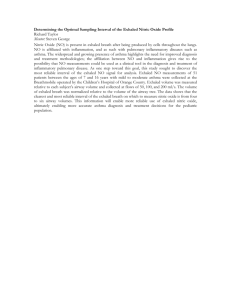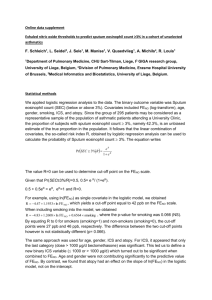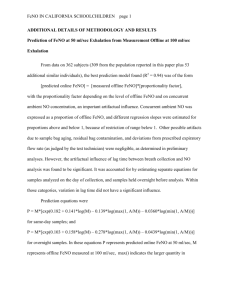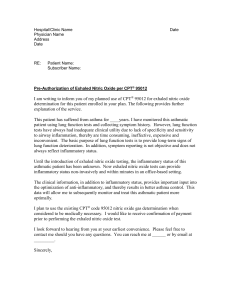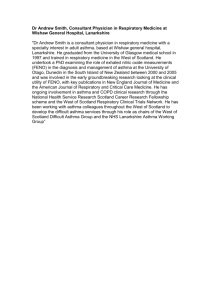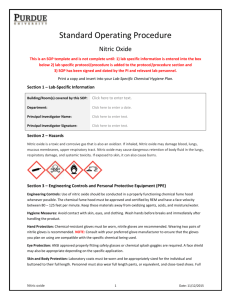Effect of gender, age, height and weight in healthy individuals on
advertisement
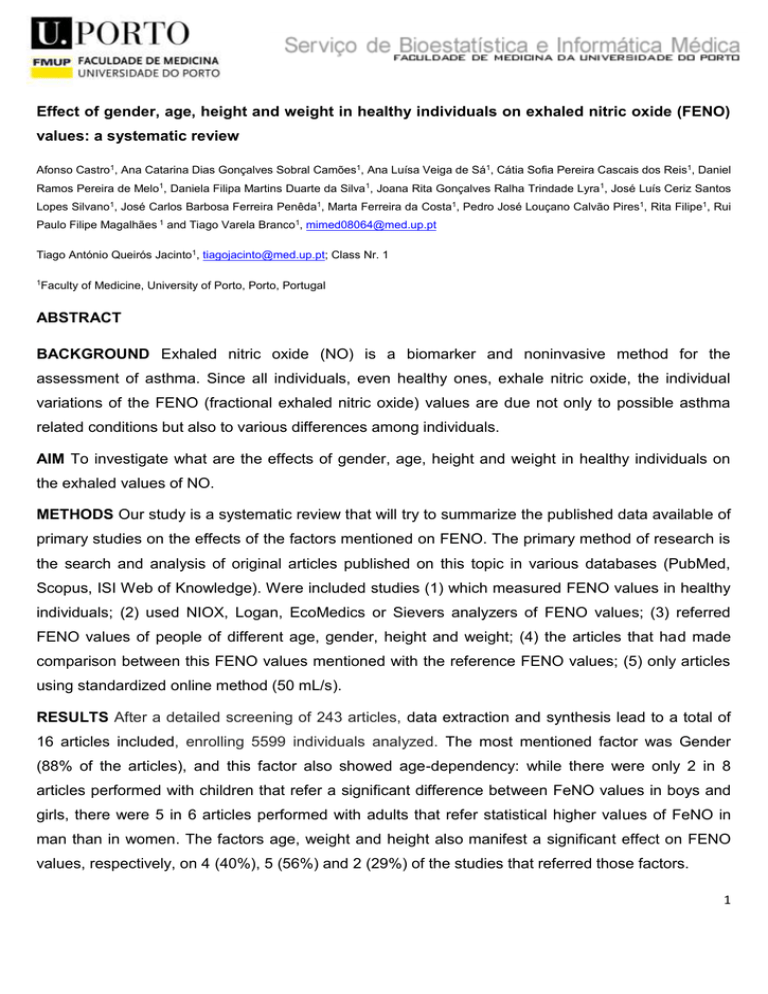
Effect of gender, age, height and weight in healthy individuals on exhaled nitric oxide (FENO) values: a systematic review Afonso Castro1, Ana Catarina Dias Gonçalves Sobral Camões1, Ana Luísa Veiga de Sá1, Cátia Sofia Pereira Cascais dos Reis1, Daniel Ramos Pereira de Melo1, Daniela Filipa Martins Duarte da Silva1, Joana Rita Gonçalves Ralha Trindade Lyra1, José Luís Ceriz Santos Lopes Silvano1, José Carlos Barbosa Ferreira Penêda1, Marta Ferreira da Costa1, Pedro José Louçano Calvão Pires1, Rita Filipe1, Rui Paulo Filipe Magalhães 1 and Tiago Varela Branco1, mimed08064@med.up.pt Tiago António Queirós Jacinto1, tiagojacinto@med.up.pt; Class Nr. 1 1Faculty of Medicine, University of Porto, Porto, Portugal ABSTRACT BACKGROUND Exhaled nitric oxide (NO) is a biomarker and noninvasive method for the assessment of asthma. Since all individuals, even healthy ones, exhale nitric oxide, the individual variations of the FENO (fractional exhaled nitric oxide) values are due not only to possible asthma related conditions but also to various differences among individuals. AIM To investigate what are the effects of gender, age, height and weight in healthy individuals on the exhaled values of NO. METHODS Our study is a systematic review that will try to summarize the published data available of primary studies on the effects of the factors mentioned on FENO. The primary method of research is the search and analysis of original articles published on this topic in various databases (PubMed, Scopus, ISI Web of Knowledge). Were included studies (1) which measured FENO values in healthy individuals; (2) used NIOX, Logan, EcoMedics or Sievers analyzers of FENO values; (3) referred FENO values of people of different age, gender, height and weight; (4) the articles that had made comparison between this FENO values mentioned with the reference FENO values; (5) only articles using standardized online method (50 mL/s). RESULTS After a detailed screening of 243 articles, data extraction and synthesis lead to a total of 16 articles included, enrolling 5599 individuals analyzed. The most mentioned factor was Gender (88% of the articles), and this factor also showed age-dependency: while there were only 2 in 8 articles performed with children that refer a significant difference between FeNO values in boys and girls, there were 5 in 6 articles performed with adults that refer statistical higher values of FeNO in man than in women. The factors age, weight and height also manifest a significant effect on FENO values, respectively, on 4 (40%), 5 (56%) and 2 (29%) of the studies that referred those factors. 1 KEY-WORDS: Exhaled nitric oxide; healthy individuals; gender; age; height, weight INTRODUCTION Asthma is a chronic inflammatory disorder of the airways in which many cells and cellular elements play a role. The chronic inflammation is associated with airway hyperresponsiveness that leads to recurrent episodes of wheezing, breathlessness, chest tightness, and coughing, particularly at night or in the early morning. These episodes are usually associated with widespread, but variable, airflow obstruction within the lung that is often reversible either spontaneously or with treatment [GINA, 2008]. A careful medical history, a physical examination, and tests of lung function provide the information needed to diagnose asthma. Measurement of lung function is useful both for diagnosis of asthma and to monitor the course of the disease. The monitoring of airway inflammation may provide evidence of asthma [Zeidler MR, 2004]. However, in clinical practice, research on asthmatic inflammation is a difficult process, involving invasive and repeated samples [Sergei A., 2006]. Exhaled biomarkers reveal themselves as a solution, as they may be used for assessment of airway inflammation and provide a non-invasive procedure that can be performed several times [Snell N, 2008], [Menzies D, 2006]. Nitric Oxide, an endogenous gas exhaled by the human body, is increasingly being used as a biomarker of inflammation in asthma. The noninvasive procedure of measuring the fraction of exhaled nitric oxide (FENO) results in values that, when correctly interpreted, lead to an efficient diagnosis and monitoring of asthma [Katial R, 2007]. However, among healthy individuals, these values express a natural variation that must be taken into account [Nadziakiewicz P, 2006]. The literature reveals that, for instance, gender, age and body size (weight and height) induce variations among the values of FENO in a healthy population. [Tsang KW, 2001], [Haight RR, 2006], [Jilma B, 1996], [Taylor DR, 2007], [Olivieri M, 2006], [Maestrelli P, 2007]. This variation, related with natural characteristics of the individuals, can act as a confounding factor when evaluating FENO for the assessment of asthma related conditions [Grob, 2008]. There are currently no systematic reviews that evaluate the effects of sex, age, height and weight on FENO values among healthy individuals that could aid the medical community in the examination of the values of this biomarker and help the optimization of asthma assessment and monitoring. Therefore, we’re going to conduct a systematic review on the effect of gender, age, height and weight in healthy individuals on exhaled nitric oxide (FENO) values. 2 METHODS Study Participants Between September 2008 and December 2008, 257 studies were included based on the following inclusion criteria p: (1) healthy individuals were population sample; (2) used NIOX, Logan, EcoMedics or Sievers analyzers of FENO values; (3) referred FENO values of people of different age, gender, height and weight; (4) the articles that had made comparison between this FENO values mentioned with the reference FENO values; (5) only articles using standardized online method (50 mL/s) [Miller MR, 2005]. We also defined exclusion criteria used in the filtration process : (1) articles not written in English or Portuguese; (2) Full-text was not available; (3) nasal NO as the only measurement; (4) articles where the flow rate of FENO was different from 50 ml/s; (6) Exhaled Breath Condensates (EBC) as the only measurement; (7) sample only composed by animals. Study Design This study is a Systematic Review. We proposed to gather and analyse the information found in different articles about the effect of gender, age, height and weight in healthy individuals on exhaled nitric oxide (FENO) values, and establish a valid correlation between their issues. Data Collection Methods Articles were searched in 3 different Databases: PubMed, Scopus and ISI Web of Knowledge, using the query: ((age OR age factors) OR (weight OR body weight) OR (height OR body height) OR (gender OR sex)) AND (exhaled nitric oxide OR eNO OR FENO) AND (healthy individuals OR (reference values OR normal values OR normative values) OR effect). As mentioned, the information was selected according to specific inclusion/exclusion criteria. These articles were submitted to different exclusion phases that reduced the original number of articles to 16. The first exclusion phase was done using the databases’ tools, in which were excluded articles not written in English or Portuguese and the ones only referring to animals. Then, the obtained articles were combined using EndNote XII® software, where the second exclusion phase occurred. We excluded, assisted by EndNote’s® tools: duplicated articles, articles that referred only to an offline method of FeNO analysis, reviews and articles with animals. In the third exclusion phase, abstracts and titles were analysed; in this step were eliminated the ones describing studies in which the measurement of FENO values was not done by using a Niox, Logan, EcoMedics or Sievers 3 measuring equipment, articles not related with FENO, articles referring only to nasal NO, articles that describe studies using a FENO flow rate different than 50 mL/s and articles referring only to EBC (exhaled breath condensate). In the fourth and last exclusion phase, articles that had no full text available were excluded. After submission to these exclusion criteria, from the 243 articles, the total included articles were 16.The information from each article was compiled, and its characteristics were described. The first table regarded: author, country, population, samples’ size, age, eNO analyser; second table: statistical analysis, studied factors and significant factors; and the third table: the proposed equation and r² from multiple linear regression analysis. Statistical Analysis The final data information was analysed using SPSS 17.0 ® software. This way, the information compiled from the 16 articles was gathered in one single table and submitted to a statistical analysis using SPSS 17.0®‘s tools. The parameters were: study, country, population, sample size (N), classification, age, eNO analyser, statistical analysis, study factors, significant factors, proposed equation and R2; the frequencies, the percent and the cumulative percent were obtained for each parameter. RESULTS Overall, 243 titles of reports of potentially relevant studies were identified and screened (Fig.1). Fig.1 – Studies Selection according to specifics inclusion/exclusion criteria. 4 In total, 78 were excluded after the first submission of the exclusion criteria and 165 abstracts were analyzed in order to apply specific criteria. 16 studies were included after a detailed review of those 165 articles. After the analysis of their full-texts, the characteristics of the articles included were registered on tables 1, 2 and 3, according with previous established data collection methods. STUDY Buchvald, 2005 Kisson, 2000a Kisson, 2002b COUNTRY Denmark,The Netherlands, Italy and USA Not Mencioned Not Mencioned Kovesi, 2008 Canada Tsang, 2001 China POPULATION POPULATION ORIGIN N AGE (years old) eNO ANALYSER Healthy children School 405 4 - 17 Niox Not Mentioned 32 15 - 18 Sievers NOA 280i Not Mentioned 112 6 - 18 Sievers NOA 280i School 657 9 - 13 Eco Medics AG CLD 88 General Population 121 20-79 Sievers NOA 280i General Population 1131 25-75 Niox General Population 1000 32 Logan Lr 2000 Healthy children Healthy children Healthy school children Non-smoking healthy women General population of men and women Individuals born in Dunedin Olin, 2007 Sweden Taylor, 2007 New Zealand Haight, 2006 USA Healthy subjects General Population 48 23 - 71 Sievers NOA 280i Nickmilder , 2007 Belgium Healthy children Summer Camps 72 6.5 - 15 Niox Baraldi, 1999 Italy Healthy children School 159 6 - 15 Ecophysics CLD 700 AlMed Wong 2005 China School 531 11 - 18 Niox 895 18 - 40 Sievers NOA 280i 122 20 - 65 Niox Levesque, 2008 USA Maestrelli, 2007 Italy Malmberg, 2006 Finland Sepponen, 2008 Finland School children Healthy African American adults Healthy Caucasian subjects Healthy school-age children Students and employees at university campuses University Occupation Health Clinic School 114 7 - 15 Niox Healthy school children School 66 7 - 13 Sievers NOA 280i 5 Olivieri, 2006 Italy Healthy non-smoking subjects Medical School Students and colleagues 204 19 - 60 Eco Medics AG CLD 88 Table 1 – Data from selected studies: author, country, population, samples’ size (N), age of the population (min-max), eNO analyser used. STUDY STATISTICAL ANALYSIS STUDIED FACTORS SIGNIFICANT FACTORS Buchvald, 2005 Linear regression multivariate analyses and Pearson correlation analysis Age, Gender, Height, Weight Height (p<0,02); Weight (p<0,005); no significant difference: Gender (p=0,27) Kisson, 2000a Determine normality of distributions, Least-squares regression, paired Student t tests used to examine the relationships between FENO values Age, Gender, Flow rates, Body surface area Gender (p = 0.015 to 0.025); No significant difference: Age (p=0,26 to 0,91) Kisson, 2002b Pearson product-moment correlation coeficients and paired Student t tests Flow rates, Age, Gender Significant difference: Gender (p not available); No significant difference: Age (p not available); Analysis of variance, multivariate regression using general linear models Age, Gender, Height, Race, Body mass index, Body surface area, Pulmonary function, Prematurity, Exercise performed on the day of testing Race (p < 0,001); Age (p = 0,007); Height (p= 0,023); no significant difference: Gender (p=0,73); Tsang, 2001 Multiple linear regression model Age, Gender, Weight, Height, Body mass index and Body surface area Gender (p=0,001); Height (p=0,02); Weight (p<0,001); no significant difference: Age (p=0,17) Olin 2007 Multiple linear regression model Age, Height. Not mentioned Univariate and multivariate linear regression Wilcoxon rank sum test paired student's test, one-way ANOVA, Dunnett'se multiple comparison test, Kolmogorov-Smirnov (K-S) test, student’s t-test and pearson correlation coefficients Gender , Height , Weight , Lung Function Indices Age Age, Height, Weight, Body Mass Index, Sex and ambient O3 Concentration Gender, Age, Height p < 0.05 Wong 2005 ------------ Gender p < 0,001 Levesque, 2008 Shapiro-Wilk W test, univariate and multivariate analysis, Student t tests, Multiple linear regression analyses Multiple linear regression Maestrelli, 2007 Stepwise regression analysis Malmberg, 2006 Stepwise regression analysis, Logistic regression analysis Height, Age, Weight, Body surface area Sepponen, 2008 Shapiro– Wilk’s test, Mann–Whitney U-test, Age, Height, Weight Kovesi, 2008 Taylor 2007 Haight, 2006 Nickmilder, 2007 Baraldi, 1999 Blood Pressure, Age, Gender, Height, Weight, Body Mass Index and Serum Total Ige, Eosinophil Cationic Protein, CReactive Protein Gender, Body size, Body Weight (Body mass index, Body surface area and dead space volume) Gender (p< 0.001) p < 0,001 p<0.05 Age (p=.0764); Gender (p<.0001); Height(p<.0001); Weight (p=.0096) Gender (p<0,001); Weight (p<0,0001) Height (p<0.0001), Age (p<0.0001), Weight (p<0.0001) Age(p=0.344), Height (p<0,001), Weight 6 Wilcoxon test, Spearman’s rank (p=0.568) correlation, Linear regression Spearman's correlation test, nonGender (p=0,01); parametric analysis of variance, Olivieri, 2006 Gender, Age no significant difference: Kruskal-Wallis test, Mann-Whitney Age (p=0,21) U test, multivariate analysis Table 2 - Statistical analysis, studied factors and significant factors referred in the selected studies STUDY PROPOSED EQUATION R (SQUARED) Buchvald, 2005 Not Mentioned Height: 0,115; Weight: 0,139 Kisson, 2000a FENO = (-0,0022 * flow) + (1,047 * body surface area) + (0,113 * age) + (0,767 * FEF 25-75) 0,98 Kisson, 2002b FENO = -0,007*flow + 0,23 * (age + 0,781 + body surface area) + 2,367 * (FEV + 0,109 + time to plateau (sec)) 0,99 Kovesi, 2008 FENO = 1.097 + 1.074 x age Age: 0,009; Height: 0,01 Tsang, 2001 Not mentioned Age: 0,0144; Height: 0,0529; Weigth: 0,1156 Olin 2007 Ln(FENO) = 0.057 + 0.013 x height (in centimeters) + 0.0088 x age (in years); non atopic subjects: Ln(FENO) = -0.0026 + 0.013 x height (in centimeters) + 0.010 x age (in years) 0,11 Taylor 2007 Not mentioned Not mentioned Haight, 2006 Not Mentioned Not Mentioned Nickmilder, 2007 Not Mentioned Not Mentioned Baraldi, 1999 Not Mentioned Age and Height: 0,04 or less Wong 2005 Not mentioned Not mentioned Levesque, 2008 Not Mentioned Sex: 0.2107 Maestrelli, 2007 Not Mentinoned Not Mentinoned Malmberg, 2006 Not Mentioned Height: 0.168, Age: 0.145, Weight: 0.155 Sepponen, 2008 FeNO = 0.423*height + 0,25 Height: 0,179 Olivieri, 2006 Not Mentioned Not Mentioned Table 3 - Proposed equation and r² from multiple linear regression analysis referred in the selected studies 7 After a detailed analysis of all articles included we have summarized the effect of each factor (age, height, weight and sex) on exhaled nitric oxide values. From the 16 articles included, 9 (56%) were performed with a sample of children. The total of participants was 5599, 2082 of which were children under 18 years old (37%). The Table 4 refers the effect of each factor on FENO values, comparing children and adult participants. FACTOR PARTICIPANTS EFFECT Increase 5% Buchvald, 2005 NR Kisson, 2002b 1,45% Kovesi, 2008 Children Age ARTICLES Kisson 2002a; Nickmilder, No significant effect 2007; Baraldi, 1999; Sepponen, 2008 Adults Increase 49% Haight, 2006 No effect Tsang, 2001; Olin, 2007 Boys higher than girls 21% Kisson, 2000a 36% Wong, 2005 Buchvald, 2005; Kisson, Children 2002b; Kovesi, 2008; No significant effect Nickmilder, 2007; Baraldi, 1999; Malmberg, 2006 Gender Man higher than women 35% Adults Children Height Children Weight Adults 19% Olin, 2007 25% Taylor, 2007 25% Maestrelli,2007 15% Olivieri, 2006 No significant effect Levesque, 2008 Increase NR Buchvald, 2005 NR Kovesi, 2008 50% Malmberg, 2006 NR Sepponen, 2008 No significant effect Adults Tsang, 2001 Increase NR Nickmilder, 2007; Baraldi, 1999; Wong, 2005 Tsang, 2001 No significant effect Levesque, 2008 Increase NR Buchvald, 2005 No significant effect Increase NR No significant effect Nickmilder, 2007;Wong, 2005; Sepponen, 2008 Tsang, 2001 Olin, 2007; Levesque, 2008 Table 4 - Effect of age, gender, height and weight on FENO values, comparing children and adult participants from the 16 articles review. NR – Not Reported. The most referred factor from the articles included was Gender (14 articles, 88%), and from these 7 (50%) reported a significant difference between males and females. This effect was specially 8 reported when the sample was constituted by adult subjects (71%). Age, weight and height also manifest a significant effect on FENO values, respectively, on 4 (40%), 5 (56%) and 2 (29%) of the studies that referred those factors. DISCUSSION Our study is, to the best of our knowledge, the first to systematically summarize the effects of age, gender, height and weight on exhaled nitric oxide (FENO) values. The most referred factor from the articles included in the study was Gender, with half of the studies showing a significant difference between different genders. Age also was a highly mentioned factor. The results showed us that, only gender showed that FeNO values were higher in men. In children, height was the only factor to show an increasing in FeNO levels. Our results suggest that is possible to study and understand the influence of anthropometric factors in FeNO, in order to find reliable reference values, aiding clinicians in the diagnosis and management of respiratory diseases. This is the first systematic review done using the three largest biomedical databases, allowing for a great number of articles found and studied. There are, however, weaknesses related with the design of the study, as any systematic review can compensate the limitations inherent of the studies included; for example, the methods and discussions of the papers were very different from one another, making both the data selection and the statistical analysis very hard to accomplish. Besides, the choice of no double revision of the articles could be one of the limitations of the study. It seems unlikely that NO production in the airways is solely a reflection of differences in airway size, but rather reflects sex-related differences in endogenous NO production. Several published studies have focused on the effects of estrogen on NOS2 and endothelial or type III NO synthase expression and NO production, suggesting that FeNO levels might be lower in women because of increased estrogen levels. Estrogen suppresses NOS2 expression in endothelial cells and reduces inflammation in NO-dependent models of inflammation and ischemic injury. We speculate that a further possible reason is the difference in airway surface area and calibre. The same flow rate in airways of different calibres may differently dilute NO, which moves by means of gaseous diffusion into a smaller lumen (i.e. in females), thus leading to a lower NO concentration.The specific effect of estrogen on FeNO levels remains unclear, but these studies suggest that estrogen might decrease FeNO levels through reduced respiratory epithelial expression of NOS2. A study of the human airway 9 cell line A549 and of human primary epithelial cells indicated that an estrogen receptor agonist blocked cytokine-stimulated NOS2 expression [Levesque, 2008]. The reason FENO increases with age is not known, but there is no age-related FENO trend in adulthood. The age dependency in children may be related to the developmental and maturational changes; increased lung volume and airway surface area; changes in airway NO diffusion coefficients, which may be dependent on surface area; or age-dependent induction of inducible nitric oxide synthase secondary to recurrent immunological stimulation. The use of a constant exhalation flow rate (50 mL/s) in children of different airway sizes may also be a factor explaining the age dependency of exhaled NO, because the same flow is relatively higher for young children. A change in NO in older people is consistent with other physiologic and biochemical changes that occur with aging such as impaired mucociliary transport, enhanced oropharyngeal colonization, increased aspiration potential, decreased ability to expectorate, decreased respiratory muscle endurance, airflow limitation, impaired immune surveillance, decreased ability to mount an appropriate immune response, impaired neutrophil chemotaxis, and respiratory burst [Haight, 2006]. The correlation between height and bronchial NO flux might be explained by increasing bronchial tree and mucosal surface area available for NO production in taller children [Sepponen,2008].The strong relationship with height in the study suggest that size of the children is more important than age, which might be related to geometrical factors such as the total area of airway mucosa producing NO, affecting the transfer factor of NO. However, age-related immunological changes may also contribute to the larger production of NO in the airways of older children. The volume of anatomic dead space is a factor explaining the body size dependency of exhaled NO in adults. Variations of dead space volume, and consequently of airway surface area, may modify the ratio between NO excretion and axial diffusion of NO from the airways to the alveolar regions of the lungs leading to an increase of FENO when the volume of anatomical dead space increases. However, even if the balance between NO excretion and its axial molecular diffusion is steady, the use of a constant exhalation flow rate for the NO measurement for all subjects irrespective of their airway size will lead to different mean airflow within the conducting airways. When velocities are increased the exhaled gas has less residence time in the conducting airways, and thus less time for the airway epithelium to load the bolus of expirate with NO, resulting in a lower exhaled NO concentrations. For a given exhalation flow rate, mean airflow velocity within conducting airways will be lower in subjects with a lower volume of anatomic dead space and vice versa [Maestrelli, 2007]. 10 A positive relation between the factors age, height, weight or gender and [FeNO] values may have a remarkable contribution to the accurate diagnosis of asthma, allergic rhinitis and several breathing diseases. In fact, if our systematic review allows the establishment of standard FeNO values and the intrinsic variations related to the enunciated factors, these same features will no longer be confusion factors. Physicians would then be able to compare the patient information with a defined reference, making the diagnosis not only more precise but also faster. Yet, the importance of finding standard values for FeNO goes far beyond the detection and diagnosis: it may dramatically simplify the monitoring and treating process. With the spread of scientific and technical improvements inherent to a major medical advance, the costs of FeNO analyzers may decrease so much that each patient could have his own. As a result, the personal monitoring of FeNO values would be the ultimate, but not disconnected consequence generated by the goal of our systematic review. And finally, further studies about this subject won’t be repetitive: this area may be exponentially developed, and is our belief that single factorial studies – for example, studying only the effect of gender in FeNO values – are the most imperative way of research. In our systematic review, we have concluded that FeNO values were higher in man than in women in articles performed with a sample of adults; also, the increasing in age, weight and height, in sames cases, was correlated with the increasing of FeNO values. Nevertheless, more studies will be needed to establish stronger relationships and reliable reference FeNO values for each factor. 11 REFERENCES Baraldi E., Azzolin N. M., Cracco A., Zacchello F. Reference values of exhaled nitric oxide for healthy children 6-15 years old. Pediatric Pulmonology. 1999; 27(1): 54-58. Buchvald F., Baraldi E., Carraro S., Gaston B., De Jongste J., Pijnenburg M., W. H., Silkoff P. E., Bisgaard H. Measurements of exhaled nitric oxide in healthy subjects age 4 to 17 years. Journal of Allergy and Clinical Immunology. 2005; 115(6): 1130-1136. GINA – The Global Initiative for Asthma, December 2007 - www.ginasthma.com Haight R. R., Gordon R. L., Brooks S. M. The effects of age on exhaled breath nitric oxide levels. Lung. 2006; 184(2): 113-119. Jilma B, Kastner J, Mensik C, Vondrovec B, Hildebrandt J, Krejcy K, Wagner OF, Eichler HG. Sex differences in concentrations of exhaled nitric oxide and plasma nitrate. Life Sci. 1996; 58(6):469-76. Katial R, Stewart L; Exhaled nitric oxide: a test for diagnosis and control of asthma? Curr Allergy Asthma Rep. 2007 Nov; 7(6):459-63. Kissoon N., Duckworth L. J., Blake K. V., Murphy S. P., Taylor C. L., Silkoff P. E. Fe-NO: Relationship to exhalation rates and online versus bag collection in healthy adolescents. American Journal of Respiratory and Critical Care Medicine. 2000; 162(2): 539-545. Kissoon, N., Duckworth L. J., Blake K. V., Murphy S. P., Taylor C. L., DeNicola L. R., Silkoff P. E. Exhaled nitric oxide concentrations: Online versus offline values in healthy children. Pediatric Pulmonology. 2002; 33(4): 283-292. Kovesi T., Kulka R., Dales R. Exhaled nitric oxide concentration is affected by age, height, and race in healthy 9-to 12-year-old children. Chest. 2008; 133(1): 169-175. Levesque M. C., Hauswirth D. W., Mervin-Blake S., Fernandez C. A., Patch K. B., Alexander K. M., Allgood S., McNair P. D., Allen A. S., Sundy J. S. Determinants of exhaled nitric oxide levels in 12 healthy, nonsmoking African American adults. Journal of Allergy and Clinical Immunology. 2008; 121(2): 396-402. Maestrelli P., Ferrazzoni S., Visentin A., Marian E., Dal Borgo D., Accordino R., Fabbri L. M. Measurement of exhaled nitric oxide in healthy adults. Sarcoidosis Vasculitis and Diffuse Lung Diseases. 2007; 24: 65-69. Malmberg L. P., Petays T., Haahtela T., Laatikainen T., Jousilahti P., Vartiainen E., Makela M. J. Exhaled nitric oxide in healthy nonatopic school-age children: Determinants and height-adjusted reference values. Pediatric Pulmonology. 2006; 41(7): 635-642. Menzies D, Nair A, Lipworth BJ. Non-invasive measurement of airway inflammation in asthma. J Asthma. 2006 Aug; 43(6):407-15. Miller M.R. et al. Series ATS/ERS task force: standardisation of lung Function testing: General considerations for lung function testing. Eur Respir J. 2005; 26: 153–161. Nadziakiewicz P, Knapik P, Rozentryt P, Ziora D, Dworniczak S, Kozielski J, Poloński L. Potential confounding factors in measurement of exhaled nitric oxide. J Physiol Pharmacol. 2006 Sep; 57 Suppl 4:223-8. Natalia M. Grob and Raed A. Dweik, MD, FCCP. Exhaled Nitric Oxide in Asthma. Cleveland, OH. 2008 Nickmilder M., Carbonnelle S., Bernard A. House cleaning with chlorine bleach and the risks of allergic and respiratory diseases in children. Pediatric Allergy and Immunology. 2007; 18(1): 27-35. Olin A. C., Bake B., Toran K. Fraction of exhaled nitric oxide at 50 mL/s: Reference values for adult lifelong never-smokers. Chest. 2007; 131(6): 1852-1856. Olivieri M, Talamini G, Corradi M, Perbellini L, Mutti A, Tantucci C, Malerba M. Reference values for exhaled nitric oxide (reveno) study. 1: Respir Res. 2006 Jun 30; 7:94. 13 Sepponen A, Lehtimäki L, Huhtala H, Kaila M, Kankaanranta H, Moilanen E. Alveolar and bronchial nitric oxide output in healthy children. Pediatric Pulmonology. 2008 Dec;43(12):1242-8. Sergei A, Kharitonov and Peter J. Barnes. Exhaled Biomarkers. Chest 2006;130;1541-1546. Snell N, Newbold P. The clinical utility of biomarkers in asthma and COPD. Curr Opin Pharmacol. 2008 Jun; 8(3):222-35. Epub 2008 May 28. Taylor D. R., Mandhane P., Greene J. M., Hancox R. J., Filsell S., McLachlan C. R., Williamson A. J., Cowan J. O., Smith A. D., Sears M. R. Factors affecting exhaled nitric oxide measurements: the effect of sex. Respiratory Research. 2007 Nov; 15(8):82. Tsang K. W., Ip S. K., Leung R., Tipoe G. L., Chan S. L., Shum I. H., Ip M. S., Yan C., Fung P. C., Chan-Yeung M., Lam W. Exhaled nitric oxide: The effects of age, gender and body size. Lung. 2001; 179(2): 83-91. Tsang KW, Ip SK, Leung R, Tipoe GL, Chan SL, Shum IH, Ip MS, Yan C, Fung PC, Chan-Yeung M, Lam W. Exhaled nitric oxide: the effects of age, gender and body size. Lung. 2001; 179(2):83-91. Wong G. W. K., Liu E. K. H., Leung T. F., Yung E., Ko F. W. S., Hui D. S. C., Fok T. F., Lai C. K. W. High levels and gender difference of exhaled nitric oxide in Chinese schoolchildren. Clinical and Experimental Allergy. 2005; 35(7): 889-893. Zeidler MR, Kleerup EC, Tashkin DP. Exhaled nitric oxide in the assessment of asthma: Curr Opin Pulm Med. 2004 Jan; 10(1):31-6. 14
